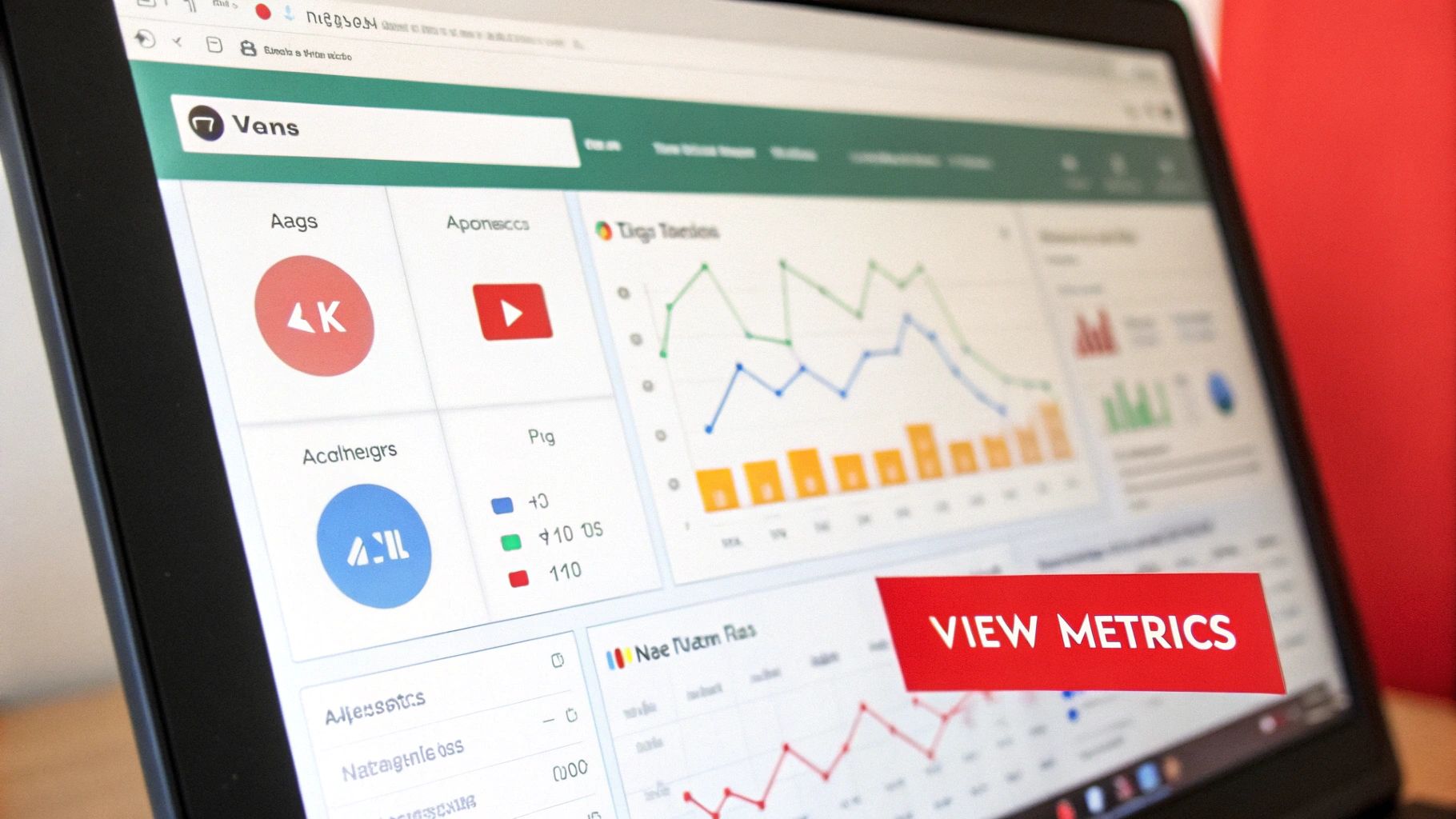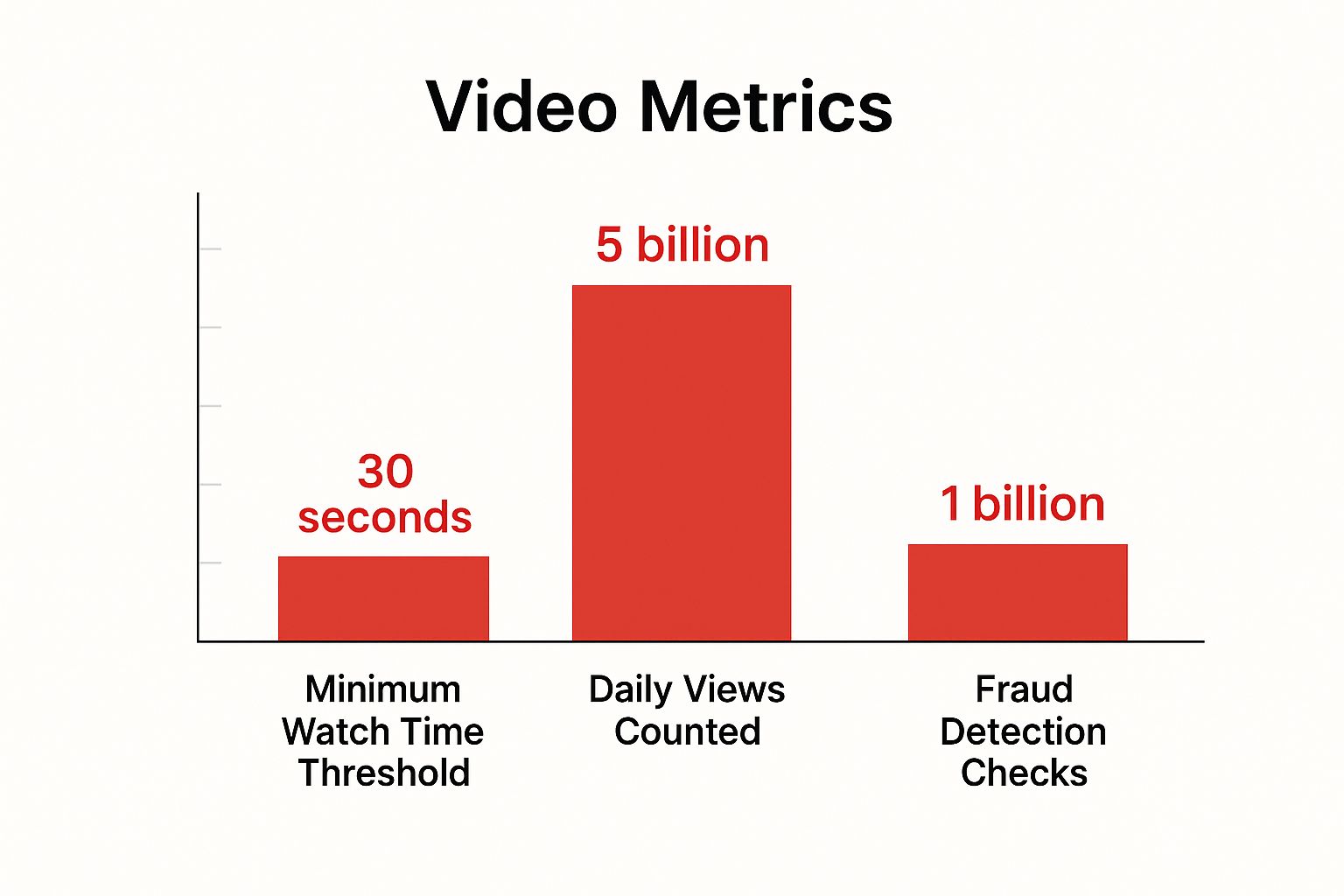The Science Behind How YouTube Counts Views

How does YouTube count views? It's a fundamental question for creators and marketers. Understanding this seemingly simple metric is vital for channel growth and potential monetization. The answer, however, is more complex than a simple click of the play button.
The 30-Second Threshold
Historically, a 30-second watch time threshold has been a core part of YouTube's view count system. This means a viewer must watch at least 30 seconds for a view to register. This helps distinguish genuine engagement from casual browsing, ensuring views reflect real interest.
For example, a quick click and immediate exit won't count. This system provides more accurate data for creators and advertisers. It also protects against inflated view counts from bots or accidental clicks, maintaining the integrity of YouTube's system.
Beyond Simple Clicks: Measuring Engagement
YouTube's algorithms have evolved beyond simple clicks. They now use a more comprehensive engagement measurement system. While the 30-second benchmark is still important, other factors contribute to view counts.
These include watch time, likes, comments, shares, and overall viewer behavior. Longer watch times and active engagement signal valuable content, potentially boosting visibility in search results and recommendations. You might be interested in: How to master more about YouTube views.
YouTube Vs. Other Platforms: A Different Approach
YouTube's approach to view counting is unique. Some platforms count views after just a few seconds, or even immediately upon clicking play. Choosing the right video platform is crucial for your video strategy. YouTube, however, prioritizes sustained engagement.
This difference is why cross-platform strategies, while potentially beneficial, can sometimes hinder YouTube performance. Focusing on content tailored to YouTube’s specific view counting mechanism is essential for maximizing your view count and overall success. Understanding how YouTube counts views is increasingly important in this dynamic online environment.
YouTube's view count has been a hot topic. Historically, a view is counted after at least 30 seconds of watch time. This metric helps creators understand content engagement and advertisers assess ad effectiveness. In 2023, YouTube Shorts generated over 70 billion views daily, with the average Short exceeding 15 seconds.
This shows a shift towards shorter content. As of 2025, YouTube has over 2.70 billion users globally, contributing to massive view counts. Find more detailed statistics here. This further highlights the importance of understanding the nuances of YouTube's view counting system.
Inside YouTube's View Fraud Detection
This section explores how YouTube separates real views from fake ones. The platform uses a strong, multi-layered system to fight attempts to inflate view counts. This ongoing battle between YouTube's security measures and those trying to cheat the system is a key part of understanding how YouTube counts views.
Identifying Manipulation: More Than Just 30 Seconds
YouTube's view count system revolves around the 30-second watch time, but it involves much more than just measuring how long someone watches a video. It uses a complex network of checks to find and remove fake activity. This includes looking at engagement patterns to tell the difference between real people watching and artificial inflation.
For example, sudden increases in views from questionable sources or strange viewing habits can trigger warnings.
How to Spot Fake Views
There are several signs that point to possible view manipulation. Here are a few examples:
- Bots: These automated programs create artificial views without any real people involved.
- Bought Views: Purchasing views from services that use bots or other shady methods.
- Too Many Repeat Views: While rewatches count to a certain degree, an unusually high number from one person looks suspicious.
- Spam: Comments with misleading links aimed at driving traffic away from YouTube are often connected to view boosting scams.
YouTube's Defenses: A Multi-Pronged Strategy
YouTube uses several different methods to stop these tactics:
- IP Address Tracking: Following the origin of views to find suspicious patterns or bot activity.
- View Speed Checks: Analyzing how quickly views are increasing on a video.
- User Behavior: Looking at how people interact with videos, including likes, comments, and shares, not just watch time.
- Machine Learning: These algorithms are constantly improving to catch new ways people try to manipulate views.
To illustrate these points, let's look at the following comparison:
View Manipulation Tactics vs. YouTube's Defense Systems
This table breaks down common view boosting tricks and the technology YouTube uses to combat them.
| Manipulation Technique | How Manipulators Implement It | YouTube's Detection Methods | Potential Channel Consequences |
|---|---|---|---|
| Bots/Automated Systems | Using software to generate artificial views. | IP address analysis, view velocity monitoring, behavioral analysis. | View removal, account suspension, or termination. |
| Paid Views from Unreliable Sources | Purchasing views from services offering illegitimate methods. | View velocity monitoring, behavioral analysis, machine learning. | View removal, account suspension, or termination. |
| Excessive Repeat Views | Artificially inflating view counts through repeated viewing from a single source. | IP address analysis, behavioral analysis. | View removal. |
| Misleading Comments/Links | Posting spam comments with links to external sites to drive traffic. | Spam detection filters, behavioral analysis. | Comment removal, account warnings. |
As you can see, YouTube takes a serious stance against manipulation.

This infographic shows some key data about YouTube's view count system, including the minimum watch time, daily views, and fraud detection efforts. It highlights the huge scale of YouTube's viewership (5 billion daily views) and the significant resources they put into fraud detection (1 billion checks). This shows YouTube's commitment to keeping view counts accurate.
Following the Rules: Protecting Your Channel
Even things that seem harmless can sometimes trigger YouTube's fraud detection. For example, promoting your videos too aggressively using questionable methods or participating in view-for-view exchanges can raise red flags.
Building a successful channel means focusing on quality content that attracts real engagement. Creators who prioritize their audience and follow YouTube's rules are more likely to achieve long-term success without putting their channel at risk. This leads to a better understanding of how YouTube counts views, which ultimately helps your content strategy.
Mastering YouTube Analytics For View Count Success

Growing a successful YouTube channel takes more than just great content. It also requires understanding how YouTube counts views and using that knowledge to improve your strategy. This means diving into your data and figuring out what really drives success.
Understanding YouTube Analytics
YouTube provides a powerful analytics dashboard within YouTube Studio. This dashboard offers a ton of information about your viewers and their interaction with your content. This data can be incredibly valuable for optimizing your content strategy for the long haul. You can learn more on how to master YouTube analytics here.
For example, you can discover where your views originate (search, suggested videos, etc.), which demographics are watching, and average view durations. This detailed information lets you identify what's working and what needs improvement.
Additionally, several third-party platforms can boost your analytical capabilities. These tools often offer more specialized metrics and different ways of looking at your channel's performance. They can reveal hidden patterns and insights that the standard YouTube analytics might miss.
Key Metrics For Success
While views are important, they aren’t the only measure of success. Other key metrics offer a more complete view of your channel's health.
-
Audience Retention: This shows how long viewers watch your videos. High retention suggests engaging content, while low retention might indicate areas for improvement.
-
Click-Through Rate (CTR): This measures how often viewers click your thumbnails in search results or recommendations. A strong CTR usually points to compelling thumbnails and titles.
-
Engagement Signals: Likes, comments, and shares are strong indicators of audience interest. These signals also influence how YouTube's algorithm ranks your videos.
Using Data To Optimize Content
Successful creators know the value of data-driven decisions. They use analytics to understand what their audience likes and adjust their strategy accordingly. Even small tweaks based on data can have a major impact on a channel's growth.
For example, if analytics show viewers dropping off at a certain point, you might change that section or add more engaging elements. Analyzing CTR data can help you create better thumbnails and titles to attract more clicks. Knowing how accurate YouTube's view count is crucial for creators’ earnings and visibility. Social Blade is a platform that provides real-time analytics, allowing users to track view counts and engagement metrics like likes, comments, and subscribers. YouTube's own analytics offer detailed insights into audience behavior, including geographic location of views and device distribution. This data helps creators refine their content to better meet audience preferences. You can learn more about this topic here. For more on ensuring your startup's financials are in order, particularly before acquisition, see this helpful guide. By focusing on these key metrics and using data to inform your strategy, you can transform how YouTube counts views from a passive metric into an active driver of channel growth.
Critical Factors That Influence Your YouTube View Counts
Not all YouTube views are equal. Understanding how YouTube counts views involves recognizing several key factors that can significantly impact your metrics. These include video length, playback location (embedded vs. YouTube), and the device used for viewing. Seemingly small details can make a big difference in your overall view count.
Playback Location: Embedded vs. YouTube
Where your video is played significantly impacts how views are counted. Views from YouTube itself are typically given more weight than views from external embeds. This is because YouTube can more easily verify the legitimacy of views on its own platform.
Embedding your video on your website might seem like a great way to increase views. However, these embedded views aren't always counted in the same way as those on YouTube's platform. A high number of embedded views might not translate into the same boost in your public YouTube view count. This difference highlights the importance of understanding where your audience is watching your content.
Video Length and Viewer Retention
Video length and viewer engagement are critical. The 30-second threshold is a well-known benchmark, but viewer retention (how long viewers stay engaged) also matters. Longer videos have the potential for more watch time, which signals value to the YouTube algorithm.
However, this only works if your content is engaging. Shorter videos, like YouTube Shorts, might accumulate views faster because they are easily consumable. This can impact overall channel metrics.
Device Type and Viewing Context
The devices viewers use (mobile, desktop, or tablet) and how they access your video (direct links, playlists, or suggested videos) can influence how views are tallied. Views from different sources contribute differently to the overall count.
For example, views from playlists are counted differently than direct views. YouTube tracks the total minutes spent watching videos in a playlist, offering insights into viewer engagement with sequenced content. YouTube's global reach and diverse user base contribute to the complexity of its view counting system. As of 2025, YouTube's user base has grown by 0.74% from the previous year, maintaining its position as a leading platform for video content. Explore this topic further here.
YouTube Studio vs. Public View Count Discrepancies
Many creators notice a difference between the view count in YouTube Studio and the public view count. This is because YouTube Studio provides real-time data, which may include views still being verified. YouTube filters out potentially invalid views before updating the public count, which can lead to discrepancies.
This delay ensures the accuracy and integrity of your view metrics. Understanding these factors is essential for optimizing your content and distribution strategy on YouTube.
Transforming Views Into Revenue: The Creator's Guide

Beyond mere vanity metrics, YouTube views hold real economic power. Understanding how YouTube counts these views is essential for translating them into actual earnings. This section explains the relationship between view counts and monetization strategies, emphasizing how YouTube values both the quantity and the quality of your views.
Monetization Beyond Ad Revenue
While ad revenue is often the first step, diversifying income is crucial for long-term success on YouTube. This means exploring avenues beyond traditional ads and taking advantage of YouTube's features.
-
Channel Memberships: Offer special perks to paying members. This builds a dedicated community and provides a reliable income source.
-
Super Chats & Super Stickers: Viewers can pay to have their messages highlighted during live streams. This allows for direct interaction with fans and offers them a way to support your channel financially.
-
Merchandise Shelf: Sell merchandise directly on your YouTube channel, making it easy for viewers to buy products related to your content.
These methods create alternative revenue streams, reducing dependence on ad revenue alone. For more information, check out this resource: How to master YouTube monetization.
View Count Milestones and Monetization Opportunities
Reaching certain view count milestones unlocks different monetization features, increasing your earning potential as your channel expands. The following table provides a detailed breakdown:
To help understand how views translate into earnings, we've compiled a table outlining the different milestones and their associated monetization opportunities. This table, "View Count Milestones and Monetization Opportunities," details the connection between viewership, features, and potential revenue.
| View Milestone Range | Monetization Features Unlocked | Typical Revenue Potential | Creator Category Level |
|---|---|---|---|
| 1,000 Subscribers & 4,000 Valid Watch Hours | YouTube Partner Program (YPP), Ad Revenue | Varies based on CPM and niche | Emerging Creator |
| 10,000+ Subscribers | Channel Memberships (Eligibility) | Dependent on member perks and pricing | Growing Creator |
| 1,000+ Concurrent Viewers (Live) | Super Chat & Super Stickers | Highly variable based on audience engagement | Established Creator |
| Significant Audience & Brand Recognition | Merchandise Shelf, Brand Deals & Sponsorships | Substantial earning potential | Top-Tier Creator |
As you can see, building a larger audience opens up more avenues for monetization.
Maximizing Revenue Per Thousand Views (RPM)
RPM, or Revenue Per Mille (thousand views), is a key metric. It shows how much you earn for every 1,000 views. While total view count is important, optimizing your RPM is crucial for efficient monetization. This involves understanding YouTube's view counting system and tailoring your content strategy accordingly.
Several factors influence RPM:
-
Audience Demographics: Different demographics appeal to different advertisers, leading to variations in CPM (Cost Per Mille) rates.
-
Content Niche: Some niches attract higher ad rates due to greater advertiser demand.
-
Watch Time: Longer watch times result in more ad impressions, boosting RPM.
-
Engagement: Higher engagement (likes, comments, shares) indicates valuable content, potentially leading to increased ad revenue.
Case Studies: Views to Revenue in Action
Let's look at how creators at different stages can monetize their views.
-
Emerging Creators: Focus on reaching the 1,000 subscriber and 4,000 valid watch hour threshold to access the YouTube Partner Program (YPP) and start earning ad revenue.
-
Growing Creators: Diversify income by offering Channel Memberships, building a loyal following through direct fan engagement.
-
Established Creators: Leverage Super Chats and Super Stickers during live streams to increase audience interaction and generate more revenue.
By grasping these strategies and understanding how YouTube counts views, creators can effectively turn views into sustainable income. This involves not just focusing on accumulating views, but on nurturing a loyal and engaged community.
YouTube Shorts vs. Long-Form: The View Count Divide
The rise of YouTube Shorts presents creators with exciting opportunities and new challenges. One key area of confusion is how YouTube counts and values views between Shorts and traditional long-form videos. This section explores those differences, revealing how identical content can perform differently depending on the format.
How Does YouTube Count Views on Shorts?
Shorts views are counted when a user watches a Short for any duration. Even a quick glance counts as a view. This is very different from long-form videos, which typically require at least 30 seconds of watch time to register a view.
This difference exists because Shorts are part of a different ecosystem. It’s designed for quick consumption, similar to TikTok or Instagram Reels. Viewer behavior and expectations are different, leading to shorter overall watch times.
The Impact of Format on View Count
Imagine posting the same content as both a Short and a long-form video. The Short might quickly gain thousands of views because of its digestible format and placement in the YouTube Shorts feed. The long-form version, requiring more commitment, might get fewer views initially.
This contrast doesn’t necessarily mean the Short performed better. It reflects how viewers consume different formats. While many Short views can boost visibility and reach, long-form views often signal a more dedicated and engaged audience.
Balancing Shorts and Long-Form Content
Success on YouTube often involves balancing both formats. Creators can use Shorts to attract new viewers and introduce them to their channel. Shorts can also tease longer content, directing viewers to full videos.
For example, a creator could post a Short highlighting a recent cooking tutorial. This Short could link to the full tutorial on their channel, boosting traffic and increasing long-form views. This maximizes total channel views and cultivates a dedicated audience.
Algorithmic Considerations for Hybrid Creators
YouTube’s algorithm treats creators differently based on their content mix. Specializing in one format (Shorts or long-form) can have advantages, but many creators find success with a hybrid approach.
This caters to different viewing preferences and maximizes reach across YouTube. Understanding how the algorithm favors different formats for different content types is key. Entertaining content might thrive as Shorts, while in-depth content might perform better in long-form.
Monetization and the View Count Divide
Shorts contribute to overall channel visibility, but they differ from long-form videos in monetization. Long-form videos typically earn revenue through ads and other YouTube Partner Program features. Shorts, while increasingly part of monetization strategies, typically earn less revenue per view.
As YouTube prioritizes Shorts, creators must understand how to leverage both formats. This means understanding the view count divide, balancing content, and recognizing how the algorithm values different content types.
Ready to take your YouTube channel to the next level? MonetizedProfiles offers monetization-approved YouTube accounts, providing a head start for content creators. Learn more about how MonetizedProfiles can help you achieve your YouTube goals.








